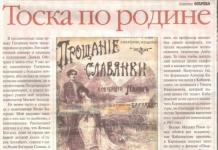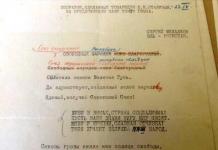Tempered in harsh battles,
Scorched in the cruel fires,
Dear country, answer us,
From the dust you, as before, ascend again!
Will we never see you again?
Has your blood dried up in your veins?
Don't you see that you are under the power of dreams?
How do rivers of bitter tears flow through you?..
When you hear such sounds, you are immediately transported to something far away..., somewhere there..., to a past, completely different life... And such marches and waltzes are usually called “antique” in publications...
In fact, almost all of them were composed not so long ago..., in the first two decades of the twentieth century..., and their authors, at that time mostly young people, lived the lives of the generation of our grandparents.., well, or great-grandmothers and great-grandfathers, who passed into Soviet times (whoever survived this turning point in life) and died within our memory already...
The beautiful march “Longing for the Motherland” is not much inferior in beauty and impact to Agapkin’s epochal one... Both of them are in minor keys, both are singable, which is so equally sweet to the Slavic soul and so distinguishes them from their cheerful Austro-German brothers...
But, unfortunately, it was not possible to find any information about its author, nor about the exact time of creation.. And do they exist at all... In different publications and records, different names are indicated.. Now Trifonov, now Croup, now Dankman, then Florov, then no one is named at all... not to mention the mass of arrangers, who were also often mistaken for authors...
In particular, the mentioned Crope is listed as a composer on a number of the first records of this march. But I myself have old sheet music, where it is written in black and white “Longing for the Motherland, arranged by Crope,” i.e. again, it seems that the interpreter was listed as the author.
However, there was also a Czech composer - Frantisek Jan Skroup (1801-1862), whose last name and initials are very similar to Croup’s (who usually write - F.E.), and the name of Skroup’s most famous song, which, by the way, became the Czech national anthem - "Where is my Motherland?", is almost identical to the name of the march in question.
Perhaps someone once took Shkroup's song as a basis and composed this march?.. By the way, when creating marches, this is exactly what they often did, starting from some existing famous song.
Farewell of Slavyanki (original) Proshanie Slavianki (original)
The moment of farewell comes,
You look anxiously into my eyes,
And I catch my native breath,
And in the distance a thunderstorm is already breathing.
The foggy and blue air trembled,
And anxiety touched my temples,
And Russia calls us to a feat,
The wind blows from the march of the regiments.
Goodbye, father's land,
Remember us
Goodbye dear look
The years are flying, flying,
The trains go into the darkness
And in them? soldiers.
And in the dark sky
The soldier's star is burning.
And in them? soldiers.
And in the dark sky
The soldier's star is burning.
Goodbye, father's land,
Remember us
Goodbye dear look
Sorry, goodbye, sorry, goodbye...
Forest and steppe, and stopovers in the steppe.
The light of evening and new dawn?
Don’t forget Slavyanka’s farewell,
Repeat it secretly in your soul!
No, the soul will not be indifferent?
The lights of justice shine...
For love, for great brotherhood
We gave our lives.
Goodbye, father's land,
Remember us
Goodbye dear look
Not all of us will come back.
The years are flying, flying,
And the song? you are always with us:
We remember you
And in the dark sky
The soldier's star is burning.
Goodbye, father's land,
Remember us
Goodbye dear look
Sorry, goodbye, sorry, goodbye...
Option by Alexander Galich
Again the vast distance before me,
The expanse of the steppe and the sky are azure.
Don't be sad, my darling
And don’t frown your black eyebrows.
Chorus:
Platoon behind the platoon.
The trumpet is calling.
An order for dispatch has arrived from headquarters.
And that means it’s time for us to go on a hike.
Don't be sad about us, our dears.
In that distant native land.
We are all still at home, peaceful,
At least we are marching in soldier ranks.
Chorus.
The dawns will give way to sunsets.
The sun will reach its zenith.
We have to die soldier after soldier.
To resurrect we are dressed in granite.
Chorus.
“Farewell of the Slav” is a Russian march written in 1912-1913 by the headquarters trumpeter of the 7th reserve cavalry regiment stationed in Tambov, Vasily Ivanovich Agapkin, under the impression of the events of the First Balkan War (1912-1913). Having not lost any of its popularity over the years, it is essentially a national march, symbolizing farewell to war, military service or a long journey. Abroad, it is one of the most recognizable musical emblems of the Russian Empire, the Soviet Union and the Russian Federation.
Waltz "Danube Waves"
Novosibirsk City Brass Band, recording from concerts
Waltz "Danube Waves" was written by the Romanian composer of Serbian origin Iosif (Ion) Ivanovici (Romanian Iosif Ivanovici, 1845-1902) in 1880, it is one of the most famous and famous Romanian melodies in the world.
Ivanovich wrote the waltz in Galati (on the Danube River), where he held the position of bandmaster of the brass band of the 6th Romanian Infantry Regiment. The waltz was first published in Bucharest in 1880 with a dedication to the wife of music publisher Constantin Gebauer, Emma.
The famous composer, author of many popular waltzes, Emile Waldteufel, made an orchestral arrangement of the melody in 1886, and in this form the work was first performed in 1889 at the World Exhibition in Paris, where it created a real sensation.
On the hills of Manchuria. Orchestra. Waltz
On the Hills of Manchuria is a Russian waltz from the early 20th century, dedicated to the Moksha soldiers who died in the Russo-Japanese War. Author: Shatrov Ilya Alekseevich.
In February 1905, the Moksha Infantry Regiment was surrounded by the Japanese in heavy battles between Mukden and Liaoyang. The regiment commander was killed. And when the forces of the defenders were running out and ammunition was running out, a brass band suddenly began to play in the rear of the regiment, led by bandmaster Ilya Alekseevich Shatrov, giving strength to the soldiers. The regiment managed to break through the encirclement. Of the entire regiment, only 7 musicians of the orchestra emerged alive, who were subsequently awarded the Cross of St. George and honorary silver trumpets. Bandmaster I. A. Shatrov “for distinguishing himself against the Japanese at different times” was awarded the Order of Stanislav, third degree “with swords.”
In May 1906, the Mokshansky regiment returned to its place of deployment in Zlatoust. In the summer, Ilya Shatrov created the first version of the waltz, which was called “Moksha Regiment on the Hills of Manchuria.” Shatrov dedicated the waltz to his dead friends. On September 18, 1906, the Mokshansky regiment was redeployed to Samara. Here Shatrov met and became friends with the teacher, composer and music publisher Oscar Filippovich Knaub, who provided the aspiring composer with serious assistance in completing the work on the waltz and its subsequent publication. In the summer of 1907, the sheet music of Ilya Shatrov’s waltz “The Moksha Regiment on the Hills of Manchuria” was sold in Oscar Knaub’s cheap edition store.
In Samara, in the Strukovsky Garden, on April 24, 1908, the first performance of the waltz by a brass band took place.
Both the official version and the “unofficial” versions of the origin of the marches “Farewell of the Slav” and “Longing for the Motherland” are contradictory. If there are many versions, then most likely none of them is reliable.
Everything that is in bad shape, or if the owner does not declare his rights, quickly goes into the wrong hands, is appropriated and passed off as his own, especially during the war of 1853-1821. The real author of these works is unknown.
Based on materials:
1. “Longing for the Motherland.” Black cat in a dark room. Valentin Antonov, April-June 2011. http://www.vilavi.ru/pes/toska/heimweh1.shtml
2. “Longing for the Motherland.” Around and around. Valentin Antonov, April 2013.
http://www.vilavi.ru/pes/toska/vokrug.shtml
3. Blank spots in the history of the “March of the Millennium”. Natalya Yakimova, July 2011.
http://1k.com.ua/381/details/2/1
4. “Farewell of the Slavic woman.” Blank spots in the history of the march. Irina Legkodukh, October 2010 - April 2012.
http://www.vilavi.ru/pes/farewell/farewell-1.shtml
Both marches - “Farewell of a Slav” and “Longing for the Motherland” - were originally created as purely orchestral works, not involving any words or singing. It should, however, be emphasized that the origin of “Homesickness” is determined more confidently - both from surviving musical editions and from texts written to its melody, which indirectly allow us to date the work itself.
Both marches are minor and incredibly similar: when listening to these two works one after another, there is a strong impression that they are parts of a single whole. Like a diptych, like shell flaps, like two leaves on one stem: a farewell march and a welcoming march.
There is a striking similarity between these two works, although they explain this in any way, often very bizarre, except for one and only logical one, namely: these two works were written by the same person.
No, it was not to the sounds of “Farewell of the Slav”, but to the sounds of “Longing for the Motherland” that Russian soldiers of the First World War went to the front. This particular march was for them a march of farewell to peaceful life, to family, to the Motherland. And it was to these sounds that people yearned for their homeland at cheerful Jewish weddings - in Berdichev and Vitebsk, in Simferopol and Odessa...
Homesickness
Try an experiment: type the phrase “Homesickness” in the search bar. As the names of the authors, you will be offered the following names to choose from: D. Trifonov, F. Croup, F. Dankman, J. Bogorad, V. Florov, A. (or S., or N.) Trofimov, L. Dunaev, as well as A. Jungmann, E. Grieg, the Chinese Ma Sy-tsung and others. Lawlessness...
In short, one of the final scenes of the comedy film “Beware of the Car” involuntarily comes to mind. Either cry or laugh...
“In all my many years of practice, a people’s judge has never had such a strange, paradoxical case…”
Collectors have all these records with pre-revolutionary recordings of “Longing for the Motherland.”
What can you say about the time of appearance of this or that gramophone recording? It is clear that recordings of the march appeared no later than 1910... and not earlier than what year?.. Well... based on the information that record collectors now have, only one thing can be said with confidence: the earliest recordings known to them were made no later than the autumn of 1905.
The first three recordings of the march “Longing for the Motherland” (at least the recordings made by the very large Gramophone company) were made in St. Petersburg in the early autumn of 1905. And about the author of the march: already in September 1905, the Gramophone company considered it to be the author of a certain Crope unknown to us. Subsequently, other record companies also named Crope as the author of the march.
This, apparently, is all that old gramophone records can tell us about today. Well... now let's see what the old sheet music editions of the march tell us...
Generally speaking, a search for sheet music editions of “Longing for the Motherland” in the catalogs of the two largest libraries in Russia and Ukraine - the Russian State Library (RSL, Leninki) and the National Library of Ukraine named after V. I. Vernadsky (NBUV) - will lead us to a list of more than hundreds of positions. But we are not interested in just any edition and not just any “Longing for the Motherland”, but in the pre-revolutionary editions of our famous march - albeit slightly differently musically, but with the same easily recognizable melody. Therefore, we will immediately cross out from the long list the works of A. Jungmann, E. Grieg, Ma Sy-tsung, Shostakovich, and so on: perhaps you will be surprised, but the feeling of “homesickness” turned out to be organically inherent in people of various nationalities and, it seems, , at all times (you can often find the German term “Heimweh” - that’s what it is, this feeling). From the rest we will cross out all Soviet publications, as well as those pre-revolutionary ones, on which, even if somewhere in a corner, it is written “Petrograd” (as St. Petersburg began to be called in September 1914, but we already know that the march was much more popular earlier). More precisely, we will not completely cross out such publications, but will only “keep them in mind” - you never know... what if we still have to compare them with something.
And how many will remain on our list then? But relatively few will remain: about two dozen - as a rule, without indicating the year of publication. In other words, for any two publications taken at random from our list, we, as a rule, cannot even say which of them appeared earlier than the other.
Even a quick glance at these old notes reveals an amazing thing. In fact, the overwhelming majority of publications do not at all hide the fact that the names written on their title pages are not the names of the authors of the march at all, but only the authors of the transcriptions and arrangements. And B. Klinov, and S. Werner, and A. Semenov, and V. Nikolaev, and M. Steinberg, and N. Tivolsky, and - attention! - F. Crope - all of them are designated in the sheet music editions of “Longing for the Motherland” not as the authors of this march, but only as the authors of its musical transcriptions and arrangements.
“I don’t know about you, but as a result of all our research, I got the following impression. Someone developed a certain beautiful marching melody, which around 1903 became well known - but not throughout Russia, but within one of its regions - for example, one province. And in 1904, as a result of the intensive movement and mixing of troops associated with the war, this melody seemed to burst into Russian open spaces, overnight becoming popular in the Far East, and in Siberia, and in Ukraine, and in the Crimea, and in the capitals . And immediately numerous transcriptions and arrangements began pouring in: in St. Petersburg, in Kharkov, in Moscow, in Kiev... Moreover, everything happened so quickly that the author of the melody, who may have been known as the author in that original region, turned out to be completely unknown on the scale of Russia — the melody seemed to have become detached from its author and became “orphan.” The arrangers willingly indicated their surnames on the title pages, but none of them, with all their desire, could confidently indicate the surname of the author of the melody.
Those who didn't have time are late. In such conditions, I’m afraid, it would be extremely difficult, if not impossible, for the real author of “Longing for the Motherland” to prove and defend his authorship...”
True, it is worth special mentioning one more contender for the authorship of the march “Longing for the Motherland”; this is the publisher, flautist and military bandmaster by his musical education, Yakov Bogorad, mentioned at the very beginning, who from about 1903 lived in the Crimea, Simferopol, and with In 1905 he published the “original” of the march “Longing for the Motherland.”
Film playwright Irina Legkoduv insists on this hypothesis, relying on the memoirs of Anastasia Tsvetaeva, the younger sister of our great poetess:
“Do you know in what connection Anastasia Ivanovna told us about the true, albeit unknown, author of “Homesickness” - the Simferopol flutist Yasha? She didn’t tell it just like that, for the sake of memories, but for edifying purposes. She raised our late close friend Seryozha Kuryokhin in this way, whom she fell in love with very much and found him very similar to the flutist Yasha.
Anastasia Ivanovna kept preaching that she had here, in Koktebel, one such friend of Yasha, a military flutist from Simferopol, who, like Seryozha Kuryokhin, was always gushing with ideas and hoaxes, but he gave away and scattered everything without any concern for authorship - after all, this was the running theme of the season for several months...
Anastasia Ivanovna said: Seryozha, you are a genius, just like he (Yasha) was, sign up, Seryozha, write down your ideas, don’t scatter.”
What do we know about Bogorad? Yes, in general, a little - especially if we are talking about the beginning of the century. Yakov Isaakovich (or Isaevich) Bogorad was born in 1879 - therefore, by 1904 he was 25 years old. Even as a child, he was fond of playing the flute, and in 1900 he graduated from the Warsaw Conservatory, receiving the qualification of a military bandmaster. As a matter of fact, after graduating from the conservatory, he was just that - a military bandmaster of the 160th Abkhazian infantry regiment stationed in Gomel. Around 1903, Bogorad moved to Simferopol, where, according to local historians, he was a military bandmaster of the 51st Lithuanian Infantry Regiment. In Simferopol, Yakov Bogorad founded the fairly well-known music publishing company “Ya. I. Bogorad and Co. “- so she was catching up with the “gone train”, publishing again and again “the work of D. M. Trifonov (original)”...
Stop, stop, stop!.. Who else is Trifonov?.. After all, we are hinting that the author of the march was Yakov Bogorad?.. Where did Trifonov come from and who is he?..
The answer to all these questions, according to Irina Legkodukh, we can easily find in the Crimean State Archive (f. 26, inventory 3, file 630). We are talking about a petition that Yakov Bogorad sent in 1907 to the governor’s office. In it, he asks to be allowed to publish the periodical “Particular Collection for Military Music.” The document indicates the petitioner's address - Simferopol, Kibler's house, st. Pushkinskaya, 6. The petition is accompanied by a certificate of trustworthiness of the applicant, signed “apt. supervising M. D. Trifonov."
Once again we give the floor to Irina Legkodukh:
“Composer Trifonov is a complete namesake, only the initials have been rearranged [it is not yet known where exactly they were rearranged: on the title page or on the certificate of trustworthiness - V.A.], the quarterly supervisor of the district in Simferopol where Kibler’s house was located: Pushkinskaya, 6, Simferopol apartment building, “bad house”, crow settlement, where many different remarkable people lived, and whose inhabitants were called “Trifonovtsy” or “Trefonovtsy”, a kind of “bohemia” in the Simferopol city folklore of the beginning of the century. So this “Tryphon” is the hero of Simferopol folklore, jokes and mockery of the artistic public.
And it’s hard to envy “composer Trifonov,” if this is the same Simferopol policeman: there was a very toothy audience hanging out there, on that Pushkinskaya street - for example, Faina Ranevskaya (who, in fact, Feldman) alone was worth something. After all, I started in the same Simferopol theater as her, so I have a very good idea of how it all happened. They simply mocked a person, found themselves a target for ridicule, he performed in their skits, was a ballerina, and wrote military marches...”
The version is witty, to be sure. Unfortunately, we are not yet able to confirm it. However, we also seem to be unable to refute it, right?
In 1928, Y. I. Bogorad even published in Simferopol a large catalog of plays and marches that he orchestrated for a brass band. In the preface it is written that Yakov Bogorad worked on this collection of music for brass bands for almost a quarter of a century and that there are over eight hundred similar works in his collection. Of these, the catalog lists over 650 works published by him in different years (right around 1904) - except, as he writes, “outdated”. Needless to say, the march “Longing for the Motherland” is not in this collection of his...
The version of Bogorad’s authorship also encounters a number of purely psychological questions. Well, just imagine: in 1903 Yakov Bogorad moved to Crimea. He is 24 years old, young and ambitious. And enterprising: soon his own music publishing company began operating in Simferopol. And so, in 1903, a wonderful melody was born to him, which he carefreely introduced to everyone, and which soon became very well known in Crimea. He is in no hurry to publish it - and in vain: unexpectedly the Russian-Japanese War broke out, and his march suddenly became famous and popular along the entire Trans-Siberian Railway, and as if by magic, numerous arrangements of his, Bogorad’s, march began to appear from everywhere.
In general, the train has left. And some time later, Bogorad rushes after him and publishes a piano version of “Longing for the Motherland” marked “original”. But here’s the strange thing: no one is stopping him from making the same profit by publishing his own march under his own name - and he is so devoid of authorial ambitions that he doesn’t even make any attempts in this direction and publishes the march under someone else's last name. But why?.. Just for fun?.. And then, with manic, truly masochistic pleasure, he publishes at least seven more reissues over the course of several years. Don’t you think that his joke went on a little long?.. But even many years later, after the revolution, no one stopped him from publishing an orchestral version in his own “Bureau of Instrumentation of Ya. I. Bogorad’s Plays” in Simferopol his march - already under his own name, because there are no longer any quarter guards... but many remember his, the flutist Yasha's, authorship...
A melody popular at Jewish weddings.
The first quarter of the 20th century was characterized by a sharp surge in the number of Jewish emigrants who arrived in the United States from the western and southern regions of Ukraine, as well as from Belarus, Lithuania, Romania and Poland. Entire families, even entire “clans”, moved overseas: once in America, far from pogroms, revolutions and wars, many sought to drag their relatives, their friends, neighbors, and just good acquaintances there.
Among the emigrants’ baggage there was also something intangible and invisible, but very “weighty”: those songs and those dances that surrounded future emigrants in their former lives and for which a little later they would even come up with a special name: klezmer. Originating among the Jews of Eastern Europe and being a product of the interpenetration and enrichment of cultures of different peoples, klezmer music initially did not carry any religious connotation and was intended to be performed at various kinds of celebrations - primarily at weddings.
Although the word klezmer had not yet been invented in 1916, klezmer music certainly already existed. What kind of melodies could be called klezmer then, we know for sure thanks to one absolutely priceless book, very sloppily published in 1916 in New York - “International Hebrew Wedding Music”, or “International Jewish Wedding Music”. This book is a collection of melodies that were very popular at that time at Jewish weddings of people from Eastern Europe. The author of the collection is a Jewish klezmer violinist, whom we know as Wolff N. Kostakowsky - that is, Wolf Kostakovsky (the publisher of the collection is a certain Nat Kostakovsky).
The main part of the collection consists of melodies, already by the name of which we recognize “purely Jewish” melodies in them: “Am Israel Chai”, “A Zekele”, “Hatickwo”, “Nes Ziono” or, say, “Seven Sorokow” (widely known we have “Seven-forty”) and “Sonia Na Balkone” (you have to understand, “Sonia on the balcony”). But there are also things in Wolf Kostakovsky’s collection that are completely unexpected for us: for example, Ilya Shatrov’s waltz “On the Hills of Manchuria” (Kostakovsky writes it as “Na Sobkach Manjuri Waltz”) and... and the march “Longing for the Motherland” (why- then also included among waltzes by Kostakovsky - “Toska Po Rodinu Waltz”)!
A certain V.N. Kostakovsky, a Jewish violinist from New York, who apparently had relatives in Odessa, included “Longing for the Motherland” in his (almost the first in the world) collection of klezmer music.
It is worth noting that in the 20s, leading American recording companies believed that the author of the march “Farewell of the Slav” was the same V.N. Kostakovsky, and not V.I. Agapkin!
Mysterious story, no words...
Farewell of Slavyanka
It is difficult to find a person who has never heard the “Farewell of the Slav” march, more than once called the “March of the Millennium”. The hypothesis about its connection with the Simferopol namesake river, as well as the fact that the famous Simferopol bandmaster and arranger Yakov Bogorad played a much larger role in the appearance of the march than is indicated in official sources, was expressed by film playwright Irina Legkodukh not so long ago. Many people were offended by this version.
alive: it was discussed, condemned, new arguments were found both for and against.
And the result is unexpected: we have to admit that the traditional version of the birth of the famous march has many blank spots.
The official history of the creation of the march “Farewell of the Slav” is known to everyone: it was written by the talented military musician Vasily Agapkin, who as a teenager joined the military regimental orchestra. After serving his emergency service, Vasily Ivanovich moved to Tambov and was enlisted as a staff trumpeter in the 7th reserve cavalry regiment stationed in the city. This service gave him the opportunity to enter a music school, which he had dreamed of all his life. By this time, the young musician was already married, his daughter was born in the same year in which 27-year-old Agapkin became a student in the brass instruments class. Vasily Agapkin himself recalled: “The march “Farewell of the Slav” was written by me on the eve of the First World War under the influence of previous events in the Balkans, when Turkey aggressively attacked the peaceful Balkan states.” Agapkin took his composition, written in a non-standard minor manner for a march, for review and subsequent instrumentation to the famous orchestrator Ya.I. Bogorad to Simferopol. Bogorad took an active part in composing its missing part, helped record the clavier, made the arrangement, orchestrated the marches, even published at his own expense 100 copies of “Farewell of the Slav” in the Simferopol printing house, which Agapkin took with him. Together they came up with the name of the march. Perhaps the Simferopol river Slavyanka, whose name so successfully coincided with the idea of the march, also played a role: a Slavic woman escorts her lover to war.
The official history of “Farewell of the Slav” is replete with so many contradictions, omissions, absurdities and completely inexplicable actions that you involuntarily begin to wonder: was this impeccable in taste, absolutely elegant Russian march really written by that young man who, with clearly not his own, and with military crosses borrowed from someone on his tunic - he poses for a photographer in a photograph of that period (on the left), almost equally elegantly showing us a leg with a spur.
The official dating of the march also raises many questions. Against the backdrop of statements about the instant and extraordinary popularity of “Farewell of a Slav” during the First World War, the almost complete absence of any sheet music, recordings, or even just some scraps, scraps of scores of that time is puzzling - they are not in private collections, neither in libraries, they are not available anywhere. There is nothing, and even the one thing that exists is known, for the most part, in the form of photographs of the cover and label. But how then did the melody of the march spread throughout Russia?.. Did it spread, as its official history assures us, like a fire - by ear, or what?..
After the 1915 recording, the next recording of “Farewell of a Slav” was made in our country only in November 1944 (Gramplasttrest, catalog number 12334). The march “Farewell of the Slav” is performed by the orchestra of the Military-Political Academy under the direction of I. V. Petrov:
Regarding the march “Farewell of the Slavic Woman,” it is believed that V. I. Agapkin wrote it in 1912, and in 1913 this march was first published. Contrary to popular belief, “Slavyanka” did not receive any widespread distribution at that time - neither as a klezmer melody (it is not in the collection of V.N. Kostakovsky, published in 1916), nor as an unofficial symbol of the state.
But in the second half of 1914, with the outbreak of the First World War, when the whole country was swept by a wave of jingoism, it would seem that there were all the prerequisites for this. And if then “Farewell of the Slav” had been at least somewhat popular, even if only among fairly wealthy citizens, we would certainly have known about it - from the surviving catalogs of record companies, from advertisements in specialized magazines, from newspaper publications, from the musical arrangement of extant before us in the recording of samples of the then jingoistic propaganda.
In the history of the march, as we see, there is clearly an episode that Vasily Agapkin himself mentions: he took sketches of the march to Simferopol to show Yakov Bogorad. He praised the composition and made a remark that it was missing one part - a trio. A classical march usually consists of a lead (verse), a chorus (bass solo) and a trio. Then they are repeated in a mirror order, which allows you to vary the execution time in parades as many times as necessary, for example, during the passage of units.
So, according to the official version of the origin of the march, which has been replicated for decades and which is based on the stories of Agapkin himself, Bogorad took an active part in the composition of the trio, helped record the clavier, made an arrangement, orchestrated the march and even published 100 copies in a Simferopol printing house at his own expense “ Farewells of a Slavic woman,” which Agapkin later took with him. Together they came up with the name of the march, in which, perhaps, the Simferopol river Slavyanka played a role, which coincided so well with the idea of the march: a Slavic woman escorting her lover to war.
But now strange things begin - it is because of them that this episode often “crashes” in versions of articles dedicated to Vasily Agapkin. It's like a pebble in a shoe - and it seems small, but it makes you limp. If you deal with this pebble, then the entire official history of the creation of the march is “lame”.
First of all, it is impossible to explain: why, exactly, did Vasily Ivanovich go from Tambov to Simferopol? Still, neither more nor less - the distance is 1224 kilometers by rail. And this is in modern terms, but at the beginning of the 20th century you also had to travel with transfers; more kilometers were covered. In those days there were no locomotives that reached speeds of 200 km/h, as they do now. The journey in one direction alone should have taken at least 4 days. In general, could Vasily Ivanovich, whose salary barely allowed him to feed his family, afford such a trip? And then, you see, it would be logical, when talking about the visit to Simferopol, to somehow explain it: perhaps, mention the benefactor who lent him money, about the leave, regarding which he had to bother with the regimental authorities - after all, the trip should have taken at least , two weeks.
Why didn’t Vasily Ivanovich move to Moscow, which was only 450 km away, or, say, to Kharkov, which was a little more than 600 km away? Why, in the end, did he not turn to a fellow musician: for example, to the bandmaster of the 7th reserve cavalry regiment, Milov, or to his mentor, music school teacher Fyodor Mikhailovich Kadichev, a talented teacher who would undoubtedly have seen the error in the construction of the march and could you tell me how to decorate it?
The biography of Vasily Agapkin is known in sufficient detail, but, oddly enough, it is precisely this central moment in his life, his finest hour - the Simferopol episode - that is “not burdened” with specific dates, or even more or less precise time intervals (assuming that the trip to Bogorad took place, then this could have happened from about mid-October to the end of November 1912).
However, the already mentioned edition of Yakov Bogorad’s “Farewell of the Slav” has not survived. Researcher M.D. Chertok in his article on the march notes:
“Researching the works of Yakov Bogorad in the Pashkov House of the Russian State Library in Moscow, we did not find any mention of Agapkin, although Bogorad, being the owner of the Bureau of Instrumentation “Bogorad and Co,” carefully recorded all his clients. His most significant client was V.V. Leisek (about 60 works). There are also quite a few orchestrations of works by Tchaikovsky, Rimsky-Korsakov, Glinka, Balakirev, Kalman, Dargomyzhsky, Schubert, J. Sousa.”
By the way, handwritten notes of the original march, made by the hand of Vasily Agapkin, are also unknown. Usually their absence is explained by the destruction of the composer’s entire archive under bombing, along with a library of six thousand (six thousand!) volumes (V.V. Sokolov, “Farewell of the Slavic Woman,” Soviet Composer, 1987). Meanwhile, the house where Agapkin’s Moscow apartment was located remains undamaged to this day.
The most surprising explanation for why handwritten musical notes were not preserved is given by Russian researcher Nikolai Gubin in his article “March of the Millennium” (Litzona Internet portal):
“It recently became known that in the fall of 1941, out of fear for the fate of her children, Olga Agapkina burned the score of the march.”
All this is completely incomprehensible, since by that time Vasily Ivanovich had been divorced from his wife Olga for more than 14 years. Let's say she kept one of the manuscripts, and she was really afraid of someone or something and destroyed the notes. But what about the archive of Agapkin himself, in which even his childhood photographs have been preserved (they can be easily found on the Internet), but there is no manuscript of “Slavyanka”?
The bravest(and certainly capable of causing rejection and indignation among many) is this: It is Yakov Bogorad who is the author of that very melody.
In 1904, he got a new job as bandmaster of the 51st Lithuanian Infantry Regiment, and wrote several marches (at least two). For example, one is for seeing off troops (not necessarily to the front - maybe for exercises), and the other is for ceremonial meetings (this is discussed in the next chapter).
“Slavyanka,” a farewell march, immediately won the love of the soldiers, so much so that they adapted the “passive” awkward text of their own composition to the memorable melody. In addition, the text is openly anti-war: well, no one is eager to fight - on the contrary, the soldiers of the Russian army are worried about being sent to the front.
The song goes far beyond the boundaries of the soldiers' barracks: it is recognizable and easy to remember. It contains protest and even some kind of parody of the very spirit of patriotism. Could it have been published then, in 1904-1905, by Yakov Bogorad? Of course not. It is more logical to assume that even without its publication he could have gotten into trouble: the authorities probably heard the march being performed without any words and understood what it had become in the soldier’s adaptation.
Version two:
Still, the melody of the song arrived from the Far East by the fall of 1904. Well, for example, with wounded soldiers. Let’s say that after treatment, which allowed them to move the road, they were able to endure several weeks on the road and get to Simferopol. The melody could well have been picked up in the barracks and on the streets and remained in favor with the people for several years. Yakov Bogorad could pay attention to it, process it in his own way, and even, perhaps, perform it with an orchestra.
In numerous publications there are references to the fact that in fact “Farewell of the Slav” was still demonstratively and publicly performed by the orchestra of the 51st Lithuanian Infantry Regiment in Simferopol back in 1910 - in memory of the fifth anniversary of the defeat of Russian troops in Japan. It is impossible to trace where the “legs” of this statement come from: no references to documents, newspaper publications, or even letters or memories of Simferopol residents are yet known. However, this statement is a persistent Simferopol legend, which many in Crimea believe in - after all, it has not yet been refuted by anyone.
Version three:
Agapkin created his own version of the march, which was based on a soldier’s song - and somehow learned about the existence of another version of it, known in Simferopol. Then it is also clear why he needed to meet with Bogorad. Or there was no trip at all, and there was correspondence between fellow musicians about this, which has not reached our time. It is doubtful, however, that Vasily Agapkin was able to escape to the Crimea in 1910-1911: this was the period when he was intensely preparing to enter the music school and mastered science there. Or there was some intermediary, knowledgeable in music and aware of the similarities of relative marches, who knew both musicians.
It is believed that very quickly the melody of the march gained worldwide fame. Later, this melody began to be performed by military bands in Bulgaria, Germany, Austria, Norway, Romania, France, Sweden, Yugoslavia and other countries. And Russian emigrants claimed that this march was known in the Entente countries, although neither recordings of the march made outside the borders of the Russian Empire, nor publications of its scores there are known.
The recognized author of the march, Vasily Agapkin, lived a long, eventful life. He survived the war in evacuation, in Novosibirsk, with the NKVD orchestra. In general, in his profession he reached heights that are the dream of any musician, and gained recognition and fame. He apparently did not complete his musical education, making up for it with practice.
It should be noted that for 27 years in a row, until 1939 and until he was fifty years old, he was not involved in composing and did not write a single piece, either good or bad, remaining the author of only “Slavyanka”.
Vasily Agapkin died at the age of 80. He was solemnly buried with military honors at the Vagankovskoye cemetery in Moscow. A line of music is engraved on his monument - the theme from “Farewell of the Slav”.
Not much is known about his peer and colleague Yakov Bogorad. In 1909, he became a teacher at the Simferopol Music School, created with his participation, and remained so until the end of his life. A researcher from Moscow Stanislav Serapinas, after searching the catalog of the Russian State Library, found there the titles of 161 works that were processed and published by Yakov Bogorad: his orchestrations, arrangements, and among them only six of his own compositions, signed by him as the author.
Generally speaking, Leninka does not store all the works processed and published by Bogorad. Back in 1928, he published in Simferopol a large catalog of plays and marches that he orchestrated for a brass band. In the preface it is written that Yakov Bogorad worked on this collection of music for brass bands for almost a quarter of a century and that there are over eight hundred similar works in his collection. Of these, the catalog lists over 650 works published by him in different years (since approximately 1904) - except, as he writes, “outdated”.
The grave of the talented musician and composer, like thousands of other Simferopol Jews, was an anti-tank ditch at the 10th kilometer of the Feodosiya highway. Yakov Bogorad walked towards her amid women's and children's cries, screams, German commands - the sounds of his last farewell march... It was 1941.
Farewell of a Slav. Best performance.
Yakov Bogorad March Longing for the Motherland (FAREWELL SLAVYANKA)
Yakov Bogorad Marsh Homesickness
https://www.youtube.com/watch?time_continue=2&v=hQVbIl4_QKk
Yakov Iosifovich Bogorad. 1930s.
YAKOV IOSIFOVICH BOGORAD
military bandmaster of the 51st Lithuanian Infantry Regiment is the real author, publisher and first performer of the march “FAREWELL SLAVYANKA”, created by him in 1904 in Simferopol. The march was later published by Bogorad in 1912 under the false name Agapkin, with cheers and patriotic slogans on the cover of the publication, caused by certain censorship circumstances, namely, the rising wave of pan-Slavic chauvinism at that time (accompanied, among other things, by a sharp increase in anti-Semitic sentiments - the next year - “The Beilis Case”).
The march is an arrangement and arrangement of ancient Hasidic synagogue melodies. The melodies are included in the Passover Haggadah. In this form, this melody was popular in Crimea among both Jewish and non-Jewish populations. In the story “Caterpillar” Kuprin describes this melody in 1905, i.e. seven years before the official publication of the march, as a song of tipsy Balaklava fishermen.
The name of the march “Farewell of the Slavyanka” comes from the name of the Simferopol river Slavyanka, on the bank of which the barracks of the Lithuanian regiment were located.
Yakov Bogorad was shot by the Nazis among thousands of Jews of Simferopol on December 12-13, 1941 in a tank ditch at the 11th kilometer of the Feodosiya highway, that is, approximately on that river.
This is Slavyanka’s farewell...
Farewell of a Slav, Amur waves, Jewish tunes as showbiz of the beginning of the last century https://6a3apob-alex.livejournal.com/220957.html
1.
2.
3.
4.
5.
what the hell kind of agapkin! tired!..


















